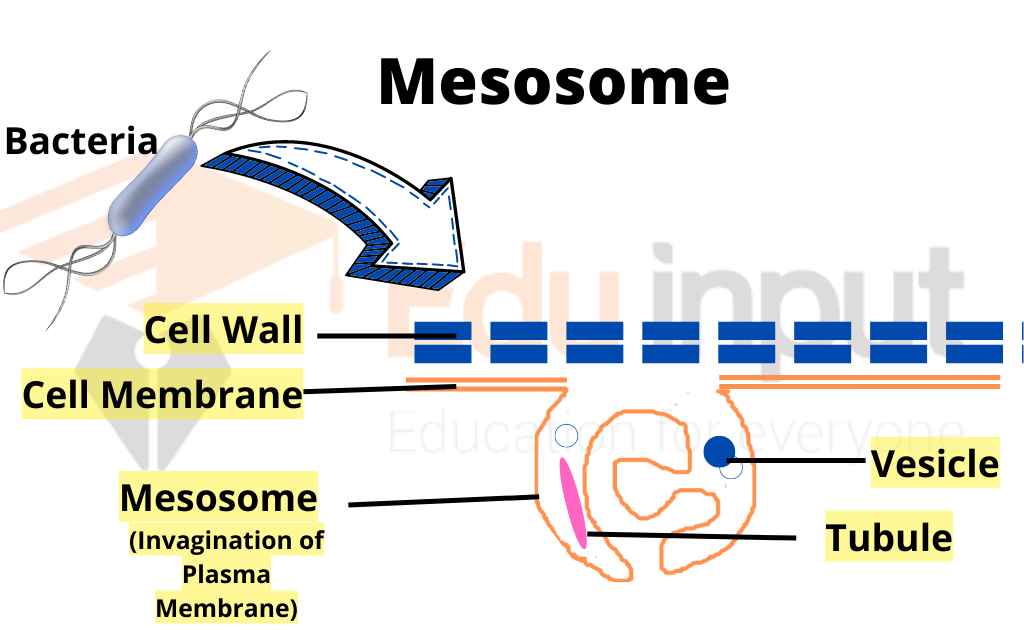Mesosome- History, Location, Structure, and Functions in Bacteria
What is Mesosome?
Mesosomes are organelle-like structures that consists of invaginations or infoldings of the plasma membrane into the cytoplasm. We may say mesosomes are derived from Plasma Membrane. They are found in bacteria. These membrane structures were originally believed to play roles in various cellular processes within bacteria, such as DNA replication, cell division, and the excretion of exoenzymes.
In eukaryotes, They are thought to be similar to the mitochondrial cristae.
Where are Mesosomes Located?
Mesosomes are visible and demonstrable using electron microscopy techniques, but their observation requires proper chemical fixation of bacterial cells to preserve their structure. The location of mesosomes within bacterial cells is closely associated with the cytoplasmic membrane, particularly at sites of septum formation during cell division.
Key Points
- Mesosomes are intracellular structures in bacteria formed from plasma membrane infoldings.
- They play a role in various cellular processes such as DNA replication and cell division, protein synthesis, and oxidative phosphorylation.
- Mesosomes have a unique shape that varies depending on the cytoplasm and nucleoids around them.
- Mesosomes are similar to mitochondrial cristae in eukaryotes.
- The role of hydrogen peroxide (H2O2) in mesosome formation and function has been studied.
- Mesosomes increase the surface area of the plasma membrane, helping with cellular respiration, enzyme secretion, and photosynthesis.
- Mesosomes are important for cell wall synthesis and equal distribution of chromosomes in daughter cells.
Historical Background
As the electron microscope was invented, Scientists found that the internal structure of the bacteria was different from other cells they had observed ever. Unlike other cells, bacteria seemed to lack the structures and organelles that help with important functions like dividing the genetic material and moving it around the cell. This was surprising because scientists knew that bacteria still had to do these things to survive, even though they didn’t have the same structures as other cells. [1]
Studies have shown that Bacterial mesosomes are structures that help them with important processes in the cell, like cell division and energy synthesis. Although scientists know about these bacterial organelles, but still they haven’t fully understood how they work. Previous research shows that hydrogen peroxide (H2O2) plays a role in mesosome formation, and the amount of excess H2O2 affects the size of the mesosomes. [2]
Structure of Mesosome
Mesosome consists of invaginations or infoldings of the plasma membrane into the cytoplasm, forming various structures:
- Invaginations of the plasma membrane: The mesosome originates from the inward folding of the cell membrane, creating a continuous compartment with the cytoplasm.
- Vesicles: Small, spherical, membrane-bound sacs or vesicles can be observed within the mesosomal structure.
- Tubules: Tubular or cylindrical membrane extensions protrude from the mesosomal invaginations.
- Lamellar whorls: These are made up of flat, stacked vesicles resembling a spiral or layered structure.
The components of mesosomes include flat vesicles, which are the building blocks of the lamellar whorls and contribute to the overall membranous structure of these organelles.

Shape of Mesosomes
Mesosomes don’t have just one set shape. Instead, their shape depends on the cytoplasm and nucleoids around them. In some cases, mesosomes have been observed to have five layers of membrane. These layers alternate between being dense and translucent, with dense layers on the outside of the membrane.
Function of Mesosome
Mesosomes play various roles in bacterial cell processes. Although their exact functions are still not known and under debate. Some functions of mesosomes in prokaryotic cells/Bacteria include:
- DNA replication – Mesosomes may provide a structural framework or scaffold for the organization and replication of bacterial DNA.
- Cell division – Their presence at sites of septum formation suggests a potential involvement in the process of cell division and chromosome segregation.
- Excretion of exoenzymes – Mesosomes may facilitate the transport and excretion of enzymes and other substances from the bacterial cell.
- Membrane synthesis and recycling – The invaginated membrane structures of mesosomes could contribute to the synthesis and recycling of cell membrane components.
- Respiratory chain enzymes – Some researchers have proposed that mesosomes may harbor respiratory chain enzymes involved in energy production.
Frequently Asked Questions-FAQs
What is another name of mesosome?
Mesosomes are also known as chondrioids. They are thought to be evolved into Mitochondria in Eukaryotic Cell.
Where is mesosome found?
Mesosomes are found in many heterotrophic bacteria. In Photosynthetic bacteria, they carry photosynthetic pigments.
Do all bacteria have mesosomes?
Only gram-positive bacteria possess mesosomes. Gram-negative bacteria don’t have mesosomes (membranous bacterial organelle).
Is mesosome an organelle?
No, mesosome is not a cell organelle, it is a membranous organelle. Because it is formed by infoldings of plasma membrane.
How mesosome help in cell wall formation?
Mesosomes are thought to be involved in delivering enzymes needed for cell wall synthesis to the growth sites. Their increased surface area might also play a role.
How mesosome help in dna replication?
Mesosomes increase the surface area for proteins involved in DNA replication to attach, anchoring them for the process. This increased space allows for efficient copying of the bacterial DNA.







Leave a Reply